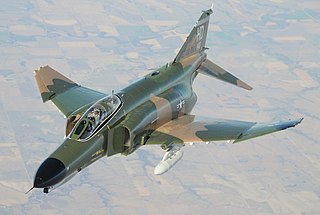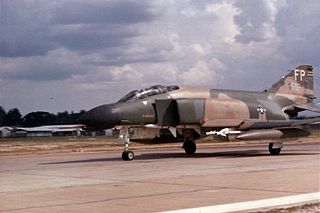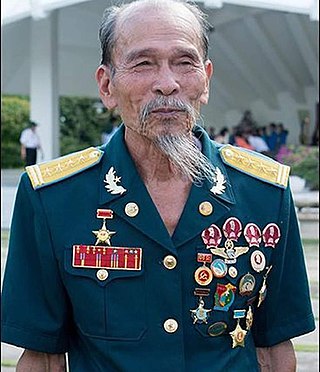
The McDonnell Douglas F-4 Phantom II is an American tandem two-seat, twin-engine, all-weather, long-range supersonic jet interceptor and fighter-bomber that was developed by McDonnell Aircraft for the United States Navy. Proving highly adaptable, it entered service with the Navy in 1961 before it was adopted by the United States Marine Corps and the United States Air Force, and by the mid-1960s it had become a major part of their air arms. Phantom production ran from 1958 to 1981 with a total of 5,195 aircraft built, making it the most produced American supersonic military aircraft in history, and cementing its position as a signature combat aircraft of the Cold War.

The Mikoyan-Gurevich MiG-17 is a high-subsonic fighter aircraft produced in the Soviet Union from 1952 and was operated by air forces internationally. The MiG-17 was license-built in China as the Shenyang J-5 and Poland as the PZL-Mielec Lim-6. The MiG-17 is still being used by the North Korean air force in the present day and has seen combat in the Middle East and Asia.

Operation Rolling Thunder was a gradual and sustained aerial bombardment campaign conducted by the United States (U.S.) 2nd Air Division, U.S. Navy, and Republic of Vietnam Air Force (RVNAF) against North Vietnam, China and North Korea from 2 March 1965 until 2 November 1968, during the Vietnam War.

Operation Linebacker II, sometimes referred to as the Christmas bombings and, in Vietnam, Dien Bien Phu in the air, was a strategic bombing campaign conducted by the United States against targets in North Vietnam from 18 December to 29 December 1972, during the Vietnam War. More than 20,000 tons of ordnance was dropped on military and industrial areas in Hanoi and Haiphong and at least 1,624 civilians were killed. The operation was the final major military operation carried out by the U.S. during the conflict, and the largest bombing campaign involving heavy bombers since World War II.

Operation Linebacker was the codename of a U.S. Seventh Air Force and U.S. Navy Task Force 77 air interdiction campaign conducted against North Vietnam from 9 May to 23 October 1972, during the Vietnam War.
Operation Flaming Dart was a U.S. and South Vietnamese military operation, conducted in two parts, during the Vietnam War.

Colonel Tomb, also Nguyen Toon or Colonel Toon was a mythical North Vietnam Air Force fighter ace loosely based on a North Vietnamese pilot from the 921st Fighter Regiment named Nguyen Van Coc. Tomb allegedly shot down 13 American aircraft during the Vietnam War. According to legend, he was killed in action on May 10, 1972, by the U.S. Navy F-4 Phantom crew of pilot Lt. Randy "Duke" Cunningham and radar operator Lt.(jg) William "Irish" Driscoll. It was later revealed by historians that there had been no such colonel in the North Vietnam forces.
Nguyễn Văn Cốc is a former North Vietnamese MiG-21 fighter ace of the Vietnamese People's Air Force's 921st Fighter Regiment.
Ubon Royal Thai Air Force Base is a Royal Thai Air Force (RTAF) facility located near the city of Ubon Ratchathani, in Ubon Ratchathani Province. It is approximately 488 km northeast of Bangkok. The Laos border is about 60 kilometres (37 mi) directly east. The facility is also used as a civil airport.

Da Nang Air Base (1930s–1975) was a French Air Force and later Republic of Vietnam Air Force (RVNAF) facility located in the city of Da Nang, Vietnam. During the Vietnam War (1959–1975), it was a major base with United States Army, United States Air Force (USAF), and United States Marine Corps (USMC) units stationed there. Air Vietnam also used the facility from 1951 to 1975 for civilian domestic and international flights within Southeast Asia.

Operation Bolo was a United States Air Force mission during the Vietnam War, considered to be a successful combat ruse.
The Thanh Hóa Bridge, spanning the Song Ma river, is situated 3 miles (4.8 km) northeast of Thanh Hóa, the capital of Thanh Hóa Province in Vietnam. The Vietnamese gave it the nickname Hàm Rồng. In 1965 during the Vietnam War, it was the objective of many attacks by US Air Force and US Navy aircraft which would fail to destroy the bridge until 1972, even after hundreds of attacks. The bridge was restored in 1973. As of 2016, the bridge still stands.

Nguyễn Văn Bảy, was a Vietnamese jet fighter ace for the Vietnam People's Air Force during the Vietnam War. Piloting a MiG-17F while assigned to the 923rd Fighter Regiment, Bay claimed 7 aerial combat victories while engaged against aircraft of the USAF and USN: 2 F-8s, 1 F-4B, 1 A-4C and 1 F-105D. Of the 7 claimed victories, 5 are acknowledged by American documents. Of 16 VPAF aces during Vietnam War, only Bay, Luu Huy Chao, and Le Hai solely flew MiG-17s.

The Vietnam People's Air Force, officially the Air Defence - Air Force Service or the Vietnam Air Force, is the aerial and air defence service branch of Vietnam. It is the modern incarnation of the so-called North Vietnamese Air Force (NVAF) and absorbed the South Vietnamese Air Force (RVNAF/VNAF) following the reunification of Vietnam in 1975 and is one of three main branches of the People's Army of Vietnam, which is under the executive administration of the Ministry of National Defence. The main mission of the VPAF is the defence of Vietnamese aerospace and the provision of air and space cover for operations of the People's Army of Vietnam.

The Bombing of Tan Son Nhut Air Base occurred on 28 April 1975, just two days before the Fall of Saigon. The bombing operation was carried out by the Vietnam People's Air Force (VPAF) Quyet Thang Squadron, using captured Republic of Vietnam Air Force (RVNAF) A-37 Dragonfly aircraft flown by VPAF pilots and RVNAF defectors led by Nguyen Thanh Trung who had bombed the Presidential Palace in Saigon on 8 April 1975.
The action of 23 August 1967 was a major air battle which involved elements of the Vietnam People's Air Force (VPAF) and the United States Air Force (USAF). The air battle took place over the skies of North Vietnam as part of Operation Rolling Thunder, during the Vietnam War.

Kép Air Base is a Vietnam People's Air Force (VPAF) (Không quân Nhân dân Việt Nam) military airfield located near the town of Kép, Bắc Giang province approximately 60 km northeast of Hanoi.

Phúc Yên Air Base is a Vietnam People's Air Force (VPAF) (Không quân Nhân dân Việt Nam) military airfield located immediately north of Noi Bai International Airport and approximately 30 km north of Hanoi.

Hòa Lạc Airfield is a Vietnam People's Air Force (VPAF) (Không quân Nhân dân Việt Nam) military heliport located approximately 24 km west of Hanoi.
Quang Lang Air Base is a former Vietnam People's Air Force (VPAF) (Không quân Nhân dân Việt Nam) military airfield located near the town of Duc Son, Nghệ An Province approximately 75 km northwest of Vinh.














